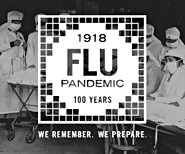Seasonal Influenza Vaccine Effectiveness, 2004-2018
CDC conducts studies to measure the benefits of seasonal flu vaccination each flu season to help determine how well flu vaccines are working. These vaccine effectiveness (VE) studies regularly assess and confirm the value of flu vaccination as a public health intervention. Study results of vaccine effectiveness can vary based on study design, outcome(s) measured, population studied and the season in which the flu vaccine was studied.
CDC has been working with researchers at universities and hospitals since the 2003-2004 flu season to estimate how well flu vaccine works through observational studies using medically attended laboratory-confirmed flu as the outcome. This is the U.S. Flu Vaccine Effectiveness (VE) Network. The U.S. Flu VE Network currently consists of five study sites across the United States that measure the flu vaccine’s effectiveness at preventing outpatient medical visits due to laboratory-confirmed influenza. CDC’s observational studies at U.S. Flu VE Network sites measure outpatient visits* for laboratory-confirmed influenza infections using a highly accurate lab test called rRT-PCR to verify the outcome. These studies compare the odds of vaccination among outpatients with acute respiratory illness and laboratory-confirmed influenza infection to the odds of vaccination among outpatients with acute respiratory illness who test negative for influenza infection.
The overall, adjusted vaccine effectiveness estimates for influenza seasons from 2004-2018 are noted in the chart below. (Estimates are typically adjusted for study site, age, sex, underlying medical conditions, and days from illness onset to enrollment.)
Info on Flu Vaccine Effectiveness
CDC conducts studies to measure the benefits of seasonal flu vaccination each flu season to help determine how well flu vaccines are working.
* Vaccine effectiveness estimates for 2017-2018 were presented to ACIP on June 20, 2018 [672 KB, 31 pages].
Top of PageFigure. Effectiveness of Seasonal Flu Vaccines from the 2004-2018 Flu Seasons
Download Excel Version [15 KB]

Text Version
This is a bar graph representing the effectiveness of seasonal flu vaccines from the 2004-05 season through the 2016-17 flu season.
On the left, the y-axis shows the effectiveness percent. The percent goes from zero to 70. Along the x-axis, it lists the flu seasons from 2004-05 to 2016-17. There are two disclaimers for flu seasons 2015-16 and 2016-17. The numbers presented for the 2015-16 flu season were CDC estimates from November 2, 2015 through April 15, 2016. The second disclaimer is that the numbers presented for the 2016-17 flu season are from a draft of a manuscript in progress.
In 2004-05, the flu vaccine was 10 percent effective.
In 2005-06, the flu vaccine was 21 percent effective.
In 2006-07, the flu vaccine was 52 percent effective.
In 2007-08, the flu vaccine was 37 percent effective.
In 2008-09, the flu vaccine was 41 percent effective.
In 2009-10, the flu vaccine was 56 percent effective.
In 2010-11, the flu vaccine was 60 percent effective.
In 2011-12, the flu vaccine was 47 percent effective.
In 2012-13, the flu vaccine was 49 percent effective.
In 2013-14, the flu vaccine was 52 percent effective.
In 2014-15, the flu vaccine was 19 percent effective.
In 2015-16, the flu vaccine was 48 percent effective.
In 2016-17, the flu vaccine was 39 percent effective.
Belongia EA, Kieke BA, Donahue JG, et al. Effectiveness of inactivated influenza vaccines varied substantially with antigenic match from the 2004-2005 season to the 2006-2007 season. J Infect Dis. 2009 Jan 15;199(2):159-67. doi:10.1086/595861. PubMed PMID: 19086915.
* From 2004-05 through 2010-11, the Network also enrolled inpatients.
† Vaccine effectiveness (VE) estimates for the 2008-2009 flu season have not yet been published.
‡ Number of patients used in VE calculation.
Top of Page- Page last reviewed: September 25, 2018
- Page last updated: November 15, 2018
- Content source:
- Centers for Disease Control and Prevention, National Center for Immunization and Respiratory Diseases (NCIRD)
- Page maintained by: Office of the Associate Director for Communication, Digital Media Branch, Division of Public Affairs



 ShareCompartir
ShareCompartir